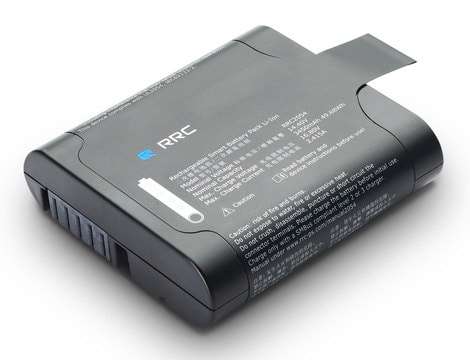LA-N-1
6041201, human nerve, Tear-drop shaped
Sinónimos:
LAN 1 Cells, LAN1 Cells
Iniciar sesiónpara Ver la Fijación de precios por contrato y de la organización
About This Item
Código UNSPSC:
41106514
Productos recomendados
product name
LA-N-1, 06041201
origen biológico
human nerve
modo de crecimiento
Semi-adherent aggregates
cariotipo
Modal no. 87, range 47 - 87
morfología
Tear-drop shaped
productos
Catecholamine
receptores
Not specified
técnicas
cell culture | mammalian: suitable
enfermedades relevantes
metastasis
Condiciones de envío
dry ice
temp. de almacenamiento
−196°C
Categorías relacionadas
Origen línea celular
Human Neuroblastoma Bone Marrow Metastasis
Descripción línea celular
Established by Seeger et al., (1977) from neuroblastoma cells in the bone marrow of a 2-year-old male with clinical Stage IV neuroblastoma. The cells are neuroblastic, tear-drop shaped with multiple short fine cell processes (neurites). The cells are tumourigenic in nude mice. This is a catecholamine producing neuroblastoma cell line.LA-N-1 (Sigma Catalogue number 06041201), LA1-55n (Sigma Catalogue number 06041203) and LA1-5s (Sigma Catalogue number 06041204) have been shown to originate from the same patient by STR profiling.
Established by Seeger et al., (1977) from neuroblastoma cells in the bone marrow of a 2-year-old male with clinical Stage IV neuroblastoma. The cells are neuroblastic, tear-drop shaped with multiple short fine cell processes (neurites). The cells are tumourigenic in nude mice. This is a catecholamine producing neuroblastoma cell line.LA-N-1 (Sigma Catalogue number 06041201), LA1-55n (Sigma Catalogue number 06041203) and LA1-5s (Sigma Catalogue number 06041204) have been shown to originate from the same patient by STR profiling.
Perfil del ADN
STR-PCR Data: Amelogenin: X,Y
CSF1PO: 12
D13S317: 11,12
D16S539: 9
D5S818: 12
D7S820: 10,11
THO1: 8,9.3
TPOX: 8,11
vWA: 16,19
CSF1PO: 12
D13S317: 11,12
D16S539: 9
D5S818: 12
D7S820: 10,11
THO1: 8,9.3
TPOX: 8,11
vWA: 16,19
Medio de cultivo
EMEM (with non-essential amino acids) and Ham′s F12 (1:1 mixture) + 2mM Glutamine + 10% Foetal Bovine Serum (FBS)
Rutina de subcultivo
For routine maintenance, split cultures only after they have become very dense i.e. split once every 2-3 weeks at a 1:20 - 1:100 ratio; 8% CO2; 37°C. Cells grow best and are most adherent on a plastic substrate in medium at a pH of 6.9 - 7.2; they do not tolerate more alkaline pH well. Population doubling time is approximately 2 days; saturation density is >1,000,000 cells/cm2. Cells grow in weakly adherent clusters. Allow all floating clumps to settle and withdraw most of the medium. Remove attached cells from substrate with 0.1% trypsin or PBS alone, cells will detach in <5 minutes. Remaining cells, if any, are large, flat and tightly adherent precursors of Schwann cell/glia/melanocyte lineages. If desired they should be removed from the substrate with trypsin/EDTA. When the neuronal cells are seeded into a new flask the cells attach slowly and may remain in suspension for one to several days; do not change the medium the day after passage. Floating clumps of cells are viable. This passage schedule will select for cells retaining a neuroblastic phenotype; cultures transferred more frequently, with larger inocula, and/or with trypsin/EDTA may gradually lose their neuroblastic properties due to overgrowth by spontaneously arising, non-neuronal adherent cell variants. When cells are resuscitated from a frozen ampoule the cells may appear dead after a day, but reattach and resume growth within 2-3 days reaching confluence by 7 days.
Otras notas
Additional freight & handling charges may be applicable for Asia-Pacific shipments. Please check with your local Customer Service representative for more information.
Certificados de análisis (COA)
Busque Certificados de análisis (COA) introduciendo el número de lote del producto. Los números de lote se encuentran en la etiqueta del producto después de las palabras «Lot» o «Batch»
¿Ya tiene este producto?
Encuentre la documentación para los productos que ha comprado recientemente en la Biblioteca de documentos.
Nuestro equipo de científicos tiene experiencia en todas las áreas de investigación: Ciencias de la vida, Ciencia de los materiales, Síntesis química, Cromatografía, Analítica y muchas otras.
Póngase en contacto con el Servicio técnico






